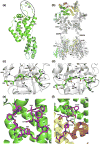Capsid-Dependent Host Factors in HIV-1 Infection
- PMID: 28528781
- PMCID: PMC5562514
- DOI: 10.1016/j.tim.2017.04.004
Capsid-Dependent Host Factors in HIV-1 Infection
Abstract
After invasion of a susceptible target cell, HIV-1 completes the early phase of its life cycle upon integration of reverse-transcribed viral DNA into host chromatin. The viral capsid, a conical shell encasing the viral ribonucleoprotein complex, along with its constitutive capsid protein, plays essential roles at virtually every step in the early phase of the viral life cycle. Recent work has begun to reveal how the viral capsid interacts with specific cellular proteins to promote these processes. At the same time, cellular restriction factors target the viral capsid to thwart infection. Comprehensive understanding of capsid-host interactions that promote or impede HIV-1 infection may provide unique insight to exploit for novel therapeutic interventions.
Keywords: HIV/AIDS; capsid; host proteins; post-entry events; virus integration; virus–host interactions.
Copyright © 2017 Elsevier Ltd. All rights reserved.
Figures


References
-
- Fassati A. Multiple roles of the capsid protein in the early steps of HIV-1 infection. Virus research. 2012;170:15–24. - PubMed
Publication types
MeSH terms
Grants and funding
LinkOut - more resources
Full Text Sources
Other Literature Sources
Medical

